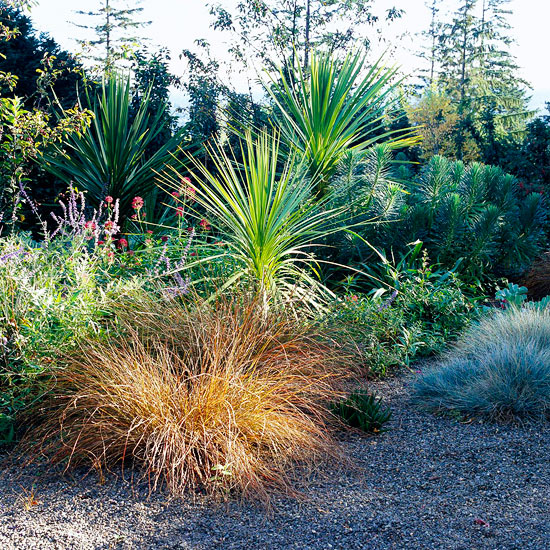






From short growing seasons to high elevations, subzero temperatures to triple-digit desert extremes, Arizona landscaping packs a lot of gardening challenges into one state. But practical -- and pretty -- ideas can conquer those difficulties. Here are tips and inspiration for making the most of your Arizona landscape.
Gardeners in the United States typically rely on the USDA Hardiness Zone Map to plot out plant choices. Many Arizona gardeners supplement that information with Sunset climate zones from The New Sunset Western Garden Book, says Peter Warren, county extension director and urban horticulture extension agent at the University of Arizona Cooperative Extension. That's because Arizona landscaping has to cope with extreme temperature ranges and other environmental factors such as lack of rain. Even so, 14 different biomes, or similar climate zones, exist within the state. However, Arizona landscaping can generally be divided into three zones, each with its own set of challenges, Warren says.
See our Zone map.
From Flagstaff to Arizona's northern border -- including the Grand Canyon -- higher elevations dominate Arizona landscaping in this section of the state. Here, the area is considered alpine, mountain, or intermountain regions. The area enjoys a very short growing season, typically just three to four months, as well as below-zero temperatures in winter and moderate heat in summer, Warren says
Although this Arizona landscaping area has a narrower Sunset climate zone range -- just 1A-3B -- it also has only 20-25 inches of moisture each year. "Even though there is precipitation, it's not as moist as it is on the East Coast, for example," Warren says. "It's a tough growing environment."
For gardeners, that translates into a longer time for plants to get established and reach maturity. It also means paying very close attention to the various microclimates in your own yard. For example, walled courtyards can provide warmth, keeping more sensitive plants better protected.
The Arizona landscaping plants that do the best on their own either have evolved to send roots deep down or thrive with very shallow roots that can quickly grab the little bit of moisture that falls. "There are always exceptions, but you have to know that the plants that are native here have evolved to survive in this climate with less water. And when you plant things that aren't from here, you need to be aware that they may not be able to take the extreme temperatures and lack of rain," Warren says.
Arizona's middle and southeastern part is a plateau, or highlands; its lower elevation provides the region with a longer growing season, as well as a wider range of Sunset climate zones: 1A-10. "It can be up to 225 days of frost-free growing," Warren says. "But it's still going to get cold there, and the precipitation is less."
In fact, in some areas, the plateau gets about half the moisture of the northern edge -- just 10-20 inches -- and summertime is hot, too. Native or well-adapted plants -- such as Arizona cypress, deciduous fruits such as apples, junipers, and some lilacs -- will do well, but again, gardeners have to be careful about when they plant. "We can have killing frosts from fall into late April, so tender perennials and annuals really can't be put out until after the first of May," Warren says.
Many people assume that because Arizona landscaping has to endure such extremes, the plant palette is limited. But xeriscaping, which is creative landscaping for water and energy efficiency and lower maintenance, can actually mean much more than just rocks and cactus. "There is a wide range of things you can plant that are flowering," Warren says. "Many can survive well, and some are native while some are non-native."
Learn more about xeriscaping.
The southern section of Arizona, including Phoenix, is like a patchwork quilt of growing potential -- and limitation. Gardeners in this mostly desert climate will find Sunset climate zones 10-13. Middle and low desert areas in the southern Arizona landscaping section experience lower temperatures, extremely low year-round precipitation, and, at times, incredibly high temperatures. "In the middle areas, they average 7-8 inches every year, and in the western low desert it's even less than that," Warren says.
One of the most challenging parts of Arizona landscaping is the wind: In wintertime, everything dries out because of the cold winds, so plants must also be able to endure that. Cacti and succulents are natural choices, but even native plants suffer from extreme cold. "Gardening here is just about different plant selection, and you have to have an open mind," Warren says. "With good fall and winter rains, wildflowers in the spring in the desert will be bursting with color."
Warren says there's actually a fifth season in some of the state. The summer, which is often hot and dry, ends with a monsoon season, usually in July and August, when daily thunderstorms can roll in from the southeast out of the Gulf of Mexico, bringing with them humidity, heavy rains, and flash floods. "It's when we get most of our rain, especially in the southern section, and it decreases plant stress" Warren says.
Find landscape ideas for the Southwest.
Check out these landscaping ideas from the Desert Botanical Garden.
Copyright © www.100flowers.win Botanic Garden All Rights Reserved